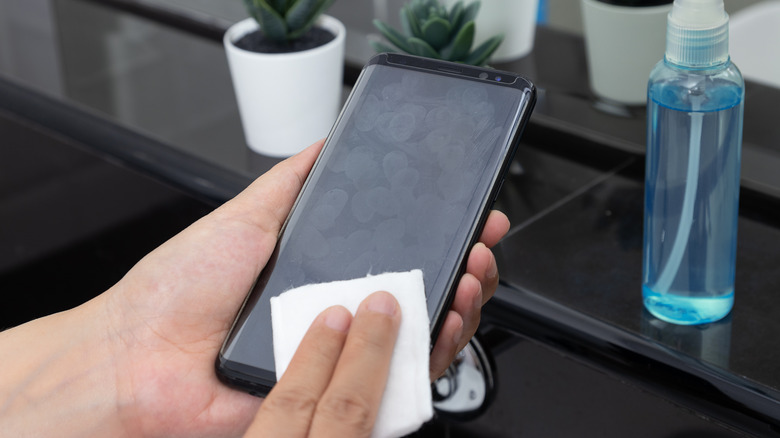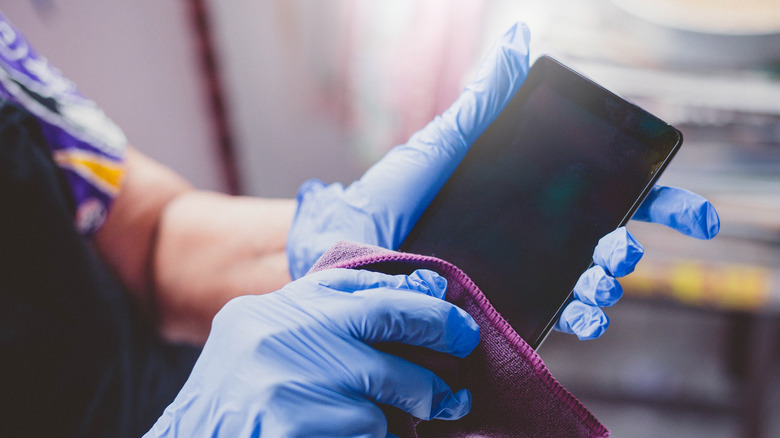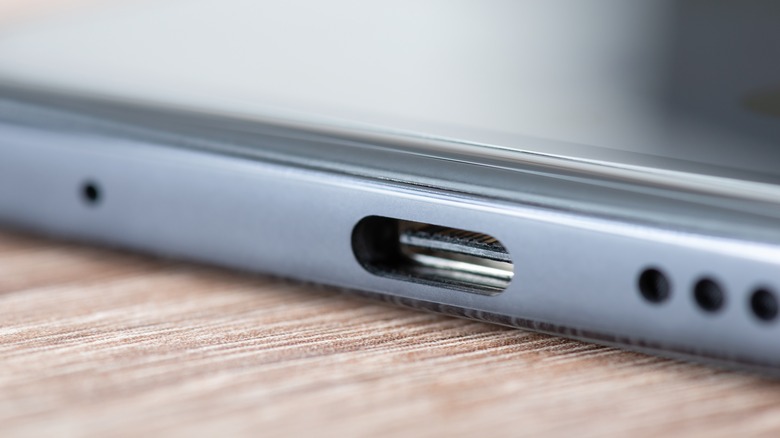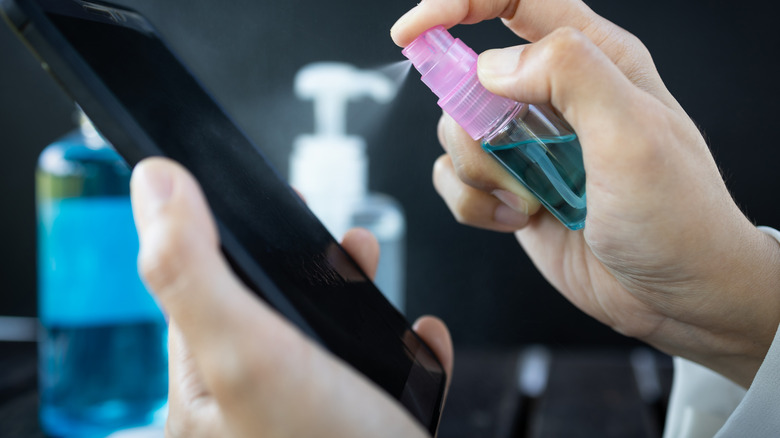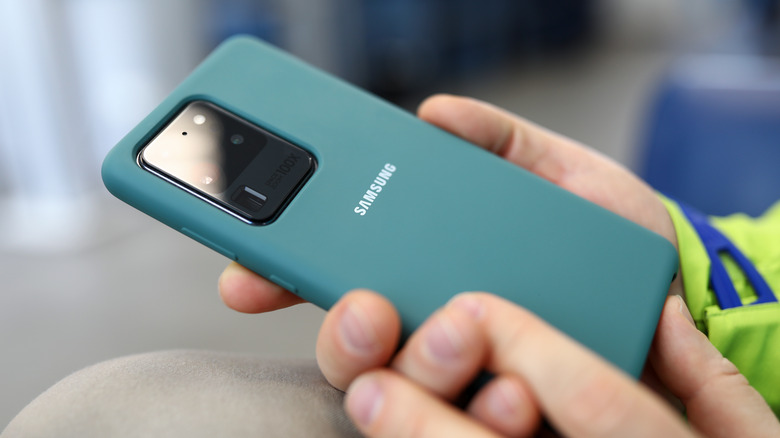How To Deep Clean An Android Device Safely
Your smartphone is something that's handled hundreds of times each day. Many people carry their phones with them at all times, including to the kitchen and the toilet. As a result, your phone comes in contact with a variety of surfaces, many of which might be dirty or covered in bacteria. In fact, a study has even claimed that phones carry 10 times more bacteria than a toilet seat. If you're cleaning your toilet every day, or even every few days, you should be doing the same with your phone.
Whether you have a water-resistant Android smartphone, or one without any protections, the method to deep clean it is pretty much the same. It's a good idea to get into the habit of cleaning your smartphone daily, and deep clean it at least once a week. Since smartphones are electronic devices, you'll need to be especially careful while cleaning them, as damaging the surface or ports can result in an expensive trip to the service center.
Deep clean your Android phone
Before cleaning your smartphone, unplug any chargers or cables, remove the case and accessories, and turn it off. The best tool to clean your phone is a microfiber cloth. This will clean the surface of the smartphone without scratching it — something regular cloth and even paper towels can't do.
If you don't have a microfiber cloth on hand, you can use the lens cloth that comes with a camera cleaning kit or glasses. Use the cloth to wipe the screen and back panel of the phone to get rid of dust and grime. Be careful not to apply too much pressure.
You can also lightly dampen the cloth with distilled water — just make sure not to get the cloth too wet. To disinfect a smartphone, most phone brands recommend using an alcohol-based solution consisting of 70 percent ethanol or isopropyl alcohol. Avoid pouring water or alcohol solution directly on the smartphone, and stick to dampening the microfiber cloth instead.
If you really want to make sure germs are dead, you can invest in a UV sterilizer light. This will kill any microbes on the surface of the phone, but won't get into the nooks and crannies.
Don't forget the speakers and ports
Cleaning the surface of a smartphone is one thing, but it's also important to remove gunk from the ports. This includes the charging port, the headphone jack (if you're lucky enough to own a phone that still has one), and the holes for the speaker and microphone. You probably don't need to be cleaning these ports daily, but it's good to give those crevices a deep clean every once in a while to make sure there's nothing lodged in there.
While it might seem tempting to use a metal pin to scrape out dirt, this can cause permanent damage to your phone. Metal conducts electricity, and smartphones are electronic devices. Use a wooden toothpick instead. Gently use the tip of the toothpick to scrape out any dirt and lint, making sure to just go around the edges of the port and not push in too deep.
Wipe down the toothpick on a piece of cloth or tissue, and repeat until all the dirt has been dislodged. Whatever you do, ensure the end of the toothpick doesn't break off inside the phone, as this can get stuck inside the ports and cause damage when pulled out. If there's any dirt collected around the ports after cleaning, use a cloth to wipe it away.
What to avoid
A Clorox wipe might get rid of any surface bacteria on your smartphone, but it can damage the glass. Some smartphone displays have an oleophobic coating that resists fingerprints and repels oil, and this can deteriorate if disinfecting wipes are used. This is particularly true of wipes that contain bleach or vinegar. Conventional glass cleaners and hand sanitizers should not be used to clean smartphones either.
Many modern Android flagships come with an IP68 water-resistance rating, but this doesn't mean they can be rinsed under running water and washed with soap. You should avoid directly spraying your smartphone with any sort of liquid, whether that's water, soap, or a household cleaner. If your smartphone gets excessively wet while cleaning, wipe it with a dry microfiber cloth and wait a few hours for the water to evaporate from the ports before attempting to charge it.
Another thing to avoid while cleaning a smartphone is using compressed air, particularly around the speakers and ports. High pressure air can blow more dust and dirt into ports, and even cause condensation if cold air comes in contact with the phone.
Clean your phone case too
Getting into the habit of deep cleaning your Android phone is great, but all that effort goes to waste if you put it back into a dirty case. Your phone's case is very likely dirtier than your phone, given that it's what comes into contact with your hands and surfaces the most. Cases are made of various materials, including rubber, silicone, plastic, and leather, and the cleaning method for each is different.
If you have a rubber, silicone, or plastic case, first wipe it down with a microfiber cloth. Next, soak the case in a solution of warm water and dish soap, and scrub it gently using an old toothbrush. Some phone cases have an inner microfiber layer that prevents the rear panel of a smartphone from getting scratched.
If your phone case has this, avoid soaking it in water, and clean the outside with a microfiber cloth that's been dampened with dish soap solution instead. You can also use a disinfecting wipe to clean your case.
If you have a leather phone case, wipe it down with a very slightly dampened cloth. Avoid too much exposure to water, as this can cause stains. You can also use a dedicated leather cleaner to wipe the case, and follow up with a conditioner to keep the material supple. After cleaning any type of phone case, it's important to let it dry completely before putting it back on the smartphone.
